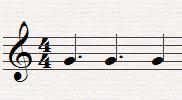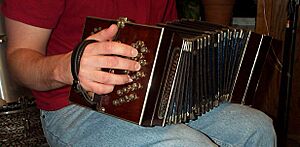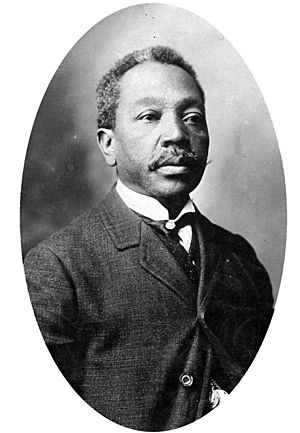Tango music facts for kids
Quick facts for kids Tango |
|
|---|---|
|
The bandoneon, an accordion-like instrument closely associated with tango
|
|
| Stylistic origins |
|
| Cultural origins | Argentina, Uruguay |
| Subgenres | |
|
|
| Fusion genres | |
| Tango-rock | |
| Regional scenes | |
|
|
| Other topics | |
|
|

Tango is a special kind of music. It has a strong beat, usually in 2/4 or 4/4 time. Tango started in Argentina and Uruguay among people who moved there from Europe and Africa.
Traditionally, tango music was played on a single guitar, or by two guitars. Sometimes, a larger group called an orquesta típica would play. This group usually has at least two violins, a flute, a piano, a double bass, and at least two bandoneóns. Sometimes, guitars and a clarinet also join in. Tango can be just music, or it can have a singer. Both tango music and its dance are now popular all over the world!
Contents
How Tango Began
Tango as we know it grew in Argentina and Uruguay in the mid-1800s. But there were similar dance styles in Cuba and Spain even earlier. Some people think the flamenco tango dance might be related to an old European dance.
Many sources say that African communities and their rhythms had a big impact on tango. Also, instruments and music styles brought by European immigrants in the 1900s helped shape tango into what it is today.
One famous early tango song is "El Choclo" by Angel Villoldo, from 1903. It was first recorded in 1906 in Philadelphia. Villoldo even recorded it in Paris because Argentina didn't have recording studios back then.
Early tango was played by immigrants in Buenos Aires and Montevideo. The first group of tango players in Buenos Aires was called "Guardia Vieja," meaning "the Old Guard." At first, tango was mostly popular with people from the poorer parts of the cities. The dances were complex and showed a mix of feelings and energy.
The music was played on instruments that could be carried easily, like flutes, guitars, and violins. The bandoneón joined in around the late 1800s. A portable player-organ called the organito also helped make some songs famous. Eduardo Arolas helped make the bandoneón very popular. Later, Vicente Greco made the standard tango group a sextet: piano, double bass, two violins, and two bandoneóns.
Like many popular music styles, tango was first linked to the working class. Some people tried to stop its growing influence. But others, like writer Ricardo Güiraldes, loved it. Güiraldes helped make tango popular around the world. By the end of World War I, tango was famous everywhere. He even wrote a poem called "Tango" about it.
Another very famous tango song, "La Cumparsita," was created around this time. The first two parts were written in 1916 by a teenage boy from Uruguay, Gerardo Matos Rodríguez. It was originally an instrumental march.
Tango's Argentine Roots
Besides influences from around the world, early tango was shaped by local music styles. These included Payada, the Milonga from the Argentine and Uruguayan countryside, and Uruguayan candombe. Milonga "from the country" existed in Argentina since the mid-1700s. The first known "payador" (a singer who improvises songs) was Santos Vega. Milonga seems to have started in the countryside with strong African influences, especially from the local candombe. This candombe style is believed to have been practiced in Argentina since the first enslaved people arrived.
The word "tango" was used to describe a music and dance style in Havana, Cuba, as early as 1823. But the first time "tango" was written about in Argentina was in an 1866 newspaper. It mentioned a song called "La Coqueta." In 1876, a tango-candombe song called "El Merenguengué" became very popular. It was a big hit at the Afro-Argentine carnival that year. This song was played with a harp, violin, and flute, along with Afro-Argentine candombe drums. Many people think this song was a key starting point for tango.
The first tango "group" had two Afro-Argentine musicians: Casimiro Alcorta (violin) and Sinforoso (clarinet). They played small concerts in Buenos Aires from the early 1870s to the early 1890s. Alcorta wrote the tango "Entrada Prohibida" and is also credited with "Concha sucia," which was later changed to "Cara sucia."
Before the 1900s, many tangos were being played. Some early ones include "El queco" (around 1885), "Señora casera" (1880), and "El Porteñito" (1880). One of the first women to write tango music was Eloísa D'Herbil. She wrote songs like "Y a mí qué" and "Che no calotiés!" between 1872 and 1885.
The first recorded tango music sheet is "La Canguela" (1889). The first tango music sheet to be officially copyrighted was "El entrerriano." It was released in 1896 and printed in 1898 by Rosendo Mendizabal, an Afro-Argentine musician.
Here are some songs that show how the old "Tango criollo" (a mix of Milonga, Afro-Argentine candombe, and some Habanera) changed into the tango of the "Old Guard":
- Ángel Villoldo - "El choclo" (1903), "El Pimpolla" (1904)
- Gabino Ezeiza - "El Tango Patagones" (1905)
- Higinio Cazón - "El Taita" (1905)
The first tango recorded by an orchestra was "Don Juan" by Ernesto Ponzio. It was recorded by Vicente Greco's orchestra.
The 1920s and 1930s: Carlos Gardel
Tango quickly became popular in Europe, starting in France. A superstar singer named Carlos Gardel helped bring tango to even more people, especially in the United States. He showed the dance in a very emotional way in his films. In the 1920s, tango became a more respected type of music and dance. Bandleaders like Roberto Firpo and Francisco Canaro changed the typical tango group by removing the flute and adding a double bass.
Carlos Gardel was very important in changing tango from music for the working class to a respected dance for everyone. He helped create tango-canción in the 1920s and became one of the most famous tango artists ever. He also helped start the "Golden Age of Tango."
After Gardel's death, tango music split into different styles. Some musicians, like Aníbal Troilo and Carlos di Sarli, wanted to evolve tango. Others, like Rodolfo Biagi and Juan d'Arienzo, preferred to stick to traditional ways.
The Golden Age of Tango
The "Golden Age" of tango music and dance is thought to be from about 1935 to 1952. This was around the same time as the big band era in the United States. During this time, tango was played by orquestas típicas, which were large bands often with more than a dozen musicians.
Some of the most popular and important orchestras included those led by Mariano Mores, Juan d'Arienzo, Francisco Canaro, and Aníbal Troilo. D'Arienzo was known as the "Rey del compás" or "King of the beat." He had a strong, driving rhythm in many of his recordings. "El flete" is a great example of his style. Canaro's early milongas (a type of tango song) were often slower and easier to dance to. Because of this, they are still played often at tango dances, called milongas. "Milonga Sentimental" is a classic example.
Starting in the Golden Age and continuing after, the orchestras of Osvaldo Pugliese and Carlos di Sarli made many recordings. Di Sarli had a rich, grand sound. He used more strings and piano than bandoneón. You can hear this in "A la gran muñeca" and "Bahía Blanca" (which was the name of his hometown).
Pugliese's early recordings were similar to other dance orchestras. But he later developed a complex, rich, and sometimes unusual sound. You can hear this in his famous songs "Gallo ciego" and "La yumba." Pugliese's later music was often played for listening, not for dancing. However, it is sometimes used for dramatic dance performances.
Eventually, tango became popular beyond Argentina and Uruguay. European bands started playing it for dances. They often added instruments that weren't traditional, like the accordion (instead of the bandoneón), saxophone, clarinet, ukulele, and electric organ. They also sang tango songs in languages other than Spanish. European tango became a popular worldwide dance and music style, like foxtrot and rumba. It developed its own European styles, different from its Argentine origins.
Famous European band leaders who played tango included Marek Weber and Paul Godwin. Popular singers like Zarah Leander and Tino Rossi also sang tango. The popularity of European tango dropped quickly when rock-n-roll became popular in the 1950s and 60s.
New Tango (Tango Nuevo)
The later period of tango has been greatly influenced by Ástor Piazzolla. His song "Adiós nonino" became one of the most important tango songs since Carlos Gardel's "El día que me quieras" in 1935. In the 1950s, Piazzolla tried to create a more academic style of tango with new sounds. This made some traditional tango fans upset.
In the 1970s, Buenos Aires saw a mix of jazz and tango music. Bands like Litto Nebbia and Siglo XX were very popular in this new style. In the 1970s and 1980s, a singing group called Buenos Aires 8 recorded classic tangos with complex arrangements and jazz influences. They also recorded an album of Piazzolla's songs.
Musicians who came after Piazzolla (from 1980 onwards) include Dino Saluzzi and Rodolfo Mederos. Piazzolla and his followers created nuevo tango (new tango). This music style mixed jazz and classical music with a more experimental tango sound.
In the late 1990s, composer and pianist Fernando Otero continued to add new ideas to tango. He used different instruments, new song structures, and even improvisation and atonal (music without a clear key) sounds in his work.
Tango in the 1990s and 2000s
In the late 1990s, a new group of tango composers and orchestras started in Buenos Aires. They played new songs but were mostly influenced by the old orchestra style, not by Piazzolla's modern experiments.
In the first 20 years of the 21st century, this movement grew. Many new bands started playing new tangos. Some of the most important groups leading this trend were Orquesta Típica Fernandez Fierro and Orquesta Típica Julián Peralta. Other bands like Orquesta Rascacielos and Ciudad Baigón also joined. There were also new singer-songwriters like Alfredo "Tape" Rubín and Victoria di Raimondo.
Electro Tango (Neotango)
Tango continued to change even after tango nuevo. Tango in the 21st century is sometimes called neotango. These newer styles are often called "electro tango" or "tango fusion." They mix electronic sounds with tango music.
Bands like Tanghetto and Carlos Libedinsky use electronic sounds in a subtle way. Their music still feels like tango, with its complex rhythms and melodies. Gotan Project is a group that started in Paris in 1999. They use electronic elements like samples, beats, and sounds mixed with a tango rhythm. Some dancers like to dance to this music, but many traditional tango dancers see it as a big change from the old style.
Bajofondo Tango Club is another example of electro-tango. Other examples can be found on CDs like Tango?, Hybrid Tango, and Tango Crash (which has a lot of jazz influence). In 2004, a music company released a collection called The Rough Guide to Tango Nuevo.
Tango in Classical Music
Even though tango music was usually played by tango musicians, a classical Argentinian pianist named Arminda Canteros (1911–2002) started playing tangos. She did this to please her father, who didn't understand classical music. She developed her own style and had a weekly radio show in Argentina in the 1930s and 1940s. Because playing tango was seen as a very masculine thing, she had to use a male name, "Juancho," for her radio shows.
Canteros moved to New York City in 1970. In 1989, when she was 78, she recorded an album called Tangos. After Canteros, another Argentinian female pianist, Cecilia Pillado, brought tango music to concert halls. She played a full tango concert at the Berliner Philharmonie in 1997 and recorded it for her CD Cexilia’s Tangos.
Since then, tango has become part of the music played by great classical musicians. Baritone singer Jorge Chaminé recorded an album called Tangos. Famous musicians like Yo-Yo Ma, Martha Argerich, Daniel Barenboim, and Plácido Domingo have also performed and recorded tangos.
Some classical composers have written tangos. These include Isaac Albéniz in España (1890) and Erik Satie in Le Tango perpétuel (1914). Igor Stravinsky wrote a tango in Histoire du Soldat (1918). Kurt Weill also used this style in "Tango Ballade" from The Threepenny Opera (1928). The accordion player John Serry Sr. composed "Tango of Love" (1955). Other composers who were inspired by tango include John Cage and Milton Babbitt. The influence of Piazzolla can be seen in many modern composers' works.
Many popular songs in the United States have used tango melodies. For example, the melody from "El Choclo" became the 1950s hit "Kiss of Fire." "Adiós Muchachos" became "I Get Ideas," and "Strange Sensation" was based on "La Cumparsita."
Tango music is still very popular today. Many international radio stations play tango music all the time.
See also
 In Spanish: Tango para niños
In Spanish: Tango para niños
- Finnish tango
- History of tango
- Latin Grammy Award for Best Tango Album
- Music of Argentina
- Music of Uruguay
- Uruguayan tango
- Vals (dance)




